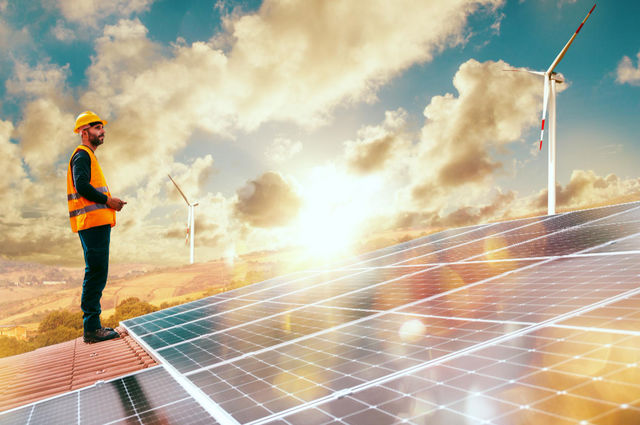This review explores the environmental impact of solar panels, with a focus on their adoption in the Sunshine State, Florida. It scrutinizes the entire life-cycle of solar panels, from production to disposal, weighing their benefits against the environmental costs.
“Is Going Solar Really Green? – Weighing Pros and Cons”
As the world increasingly turns to renewable energy sources, solar panels have emerged as a popular choice for homeowners and businesses alike. However, it is important to critically examine the environmental impact of solar panels before hailing them as the ultimate solution to our energy needs. On the one hand, solar panels offer a clean and sustainable source of energy, reducing reliance on fossil fuels and mitigating greenhouse gas emissions. This is undoubtedly a positive step towards combating climate change and preserving our planet for future generations.
On the other hand, the production and installation of solar panels come with their own set of environmental considerations. The manufacturing process involves the use of various materials, including silicon, aluminum, and glass, which have their own carbon footprints. The extraction and processing of these materials can contribute to air and water pollution, as well as habitat destruction. Additionally, the transportation of solar panels from manufacturing facilities to installation sites further adds to their carbon footprint.
Furthermore, the land required for large-scale solar installations can lead to habitat loss and disruption of ecosystems. This is particularly relevant in areas with high biodiversity or sensitive ecosystems. Additionally, the use of large amounts of water for cleaning and cooling solar panels can strain local water resources, especially in arid regions.
To truly assess the environmental impact of solar panels, a comprehensive life cycle analysis is necessary. This analysis should include the production, installation, operation, and end-of-life stages of solar panels. It is also crucial to consider the source of the electricity used for manufacturing and installation, as well as the efficiency of the solar panels themselves.
The Carbon Footprint of Solar Panels: What’s the Real Cost?
Solar panels are often hailed as a clean and sustainable energy source, but it is important to examine the carbon footprint associated with their production and installation. The manufacturing process of solar panels involves the use of energy-intensive machinery, which often relies on fossil fuels. This initial carbon footprint can be significant and it may take years for the solar panels to offset through clean energy generation. Additionally, the extraction and refining of raw materials, such as silicon and aluminum, also contribute to the carbon emissions associated with solar panel production.
The transportation of solar panels from manufacturing facilities to installation sites is another factor to consider. Depending on the distance and mode of transportation, this process can lead to additional carbon emissions. Furthermore, the carbon footprint of solar panels is influenced by their efficiency and lifespan. Higher efficiency panels require fewer units to generate the same amount of electricity, resulting in a lower overall carbon footprint. Additionally, longer-lasting panels reduce the need for frequent replacements, further reducing their carbon impact.
It is also crucial to consider the energy source used during the manufacturing process. If the electricity used comes from coal or other fossil fuel-based power plants, the carbon emissions associated with solar panel production will be higher compared to panels manufactured using renewable energy sources.
“Are We Trading One Problem for Another? – The Disposal Dilemma”
As the popularity of solar panels continues to rise, concerns about their end-of-life disposal have emerged. While solar panels have a lifespan of 25 to 30 years, eventually they will need to be replaced. The disposal of solar panels presents a unique challenge due to the presence of hazardous materials, such as lead and cadmium, which are used in the manufacturing process. Proper disposal methods must be implemented to prevent these toxic substances from entering the environment.
Currently, recycling is the most viable option for solar panel disposal. However, the recycling infrastructure for solar panels is still developing, and there are limited facilities equipped to handle this specialized process. This can lead to logistical challenges and increased costs. Additionally, the recycling process itself requires energy and resources, which can contribute to the carbon footprint associated with solar panel disposal.
Another concern is the potential for solar panels to end up in landfills. If not properly managed, the hazardous materials within the panels can leach into the soil and water, posing risks to human health and the environment. Efforts are being made to regulate the disposal of solar panels and promote responsible recycling practices. However, more research and investment are needed to improve the efficiency and accessibility of solar panel recycling.
Florida’s Solar Revolution: A Beacon for the Rest of the World?
Florida, also known as the Sunshine State, has seen a remarkable surge in solar energy adoption in recent years. With its abundant sunshine and favorable political environment, Florida has become a beacon for the rest of the world in the transition to renewable energy.
- 1. Government Support and Incentives:
One key factor driving Florida’s solar revolution is the state government’s support and incentives for renewable energy. In 2016, the Florida legislature passed a bill that removed barriers to solar power, allowing for third-party financing and the leasing of solar equipment. This has made solar installations more affordable and accessible for homeowners and businesses. Additionally, the state offers various incentives, such as tax credits and rebates, to further encourage the adoption of solar energy. - 2. Economic Benefits and Job Creation:
Florida’s solar revolution has not only contributed to environmental sustainability but also to economic growth. The solar industry has created numerous job opportunities, from installation and maintenance to manufacturing and research. According to a report by The Solar Foundation, Florida ranked second in the nation for solar job growth in 2020, with over 12,000 solar jobs. The increasing demand for solar installations has also stimulated the growth of local businesses and suppliers, boosting the overall economy. - 3. Environmental Impact:
Florida’s solar revolution has had a significant positive impact on the environment. By harnessing the abundant sunlight, solar panels generate clean and renewable energy, reducing greenhouse gas emissions and dependence on fossil fuels. This transition to solar power has helped Florida make substantial progress towards its renewable energy goals and has contributed to the global efforts in combating climate change.
Environmental Impact of Solar Panels:
| Type | Environmental Impact | Example | Example |
|---|---|---|---|
| Benefits | Reduction in emissions | Decreased dependence on fossil fuels | Reduced water consumption |
| Costs | Increased carbon footprint | Transportation of materials | Chemicals used in production |
| Benefits | Decreased land use | Less space for panels | No need for large energy plants |
| Costs | Hazardous waste from disposal | Contaminated glass and metals | Chemical leaks in landfill |
While solar panels do have an environmental cost, their adoption in Florida proves to be a significant step towards sustainable energy solutions. The mitigation of carbon emissions and other pollutants far outweighs the environmental footprint of their production and disposal. The Sunshine State, thus, sets a compelling precedent for other states and countries to follow.








